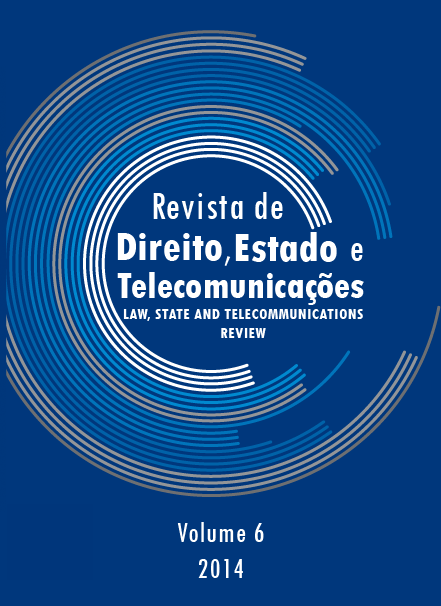The role of the Ministry of Defense in the process of integration and regulation of Military Communications in Brazil
DOI:
https://doi.org/10.26512/lstr.v6i1.21553Keywords:
Ministry of Defense. Military communications. Integration. Regulation. Brazil.Abstract
Purpose ”“ The purpose of this article is to introduce the reader to the technical and political context whereupon are inserted the Military Communications in Brazil, evidencing the regulatory and integrative role currently played by the Ministry of Defense.
Methodology/approach/design ”“ This research makes predominant use of descriptive and comparative techniques, in order to inform the reader on the subject highlighted.
Findings ”“ The article concludes with the need for rationalization and unification of national policy for Military Communications, as determinant for the effective integration of the Armed Forces in joint operations.
Practical implications ”“ The article highlights the benefits that standardization of technical requirements by the Ministry of Defense may bring in terms of reducing the cost of purchasing and maintaining equipment and military communications systems, by way of enhancing economies of scale, effectiveness and operational efficiency in the joint operations of the Armed Forces.
Originality/value ”“ This article addresses a branch of knowledge rarely assessed by academic researchers in Brazil having thus pioneering role in contributing to issues related to National Defense as Military Communications are discussed by civil society.
Downloads
References
ARAGÃO, A. Princípio da legalidade e poder regulamentar no Estado contemporâneo. In: Boletim de Direito Administrativo, v. 5, p. 370-380, maio de 2002.
ARANHA, M. I. Manual de Direito Regulatório. Scotts Valley, CA: CreateSpace, 2013.
ARANHA, M. I. Poder normativo do Executivo e teoria da regulação. In: Notícia do Direito Brasileiro, v. 9, p. 135-154, 2002.
BALDWIN, R.; CAVE, M.; LODGE, M.Understanding Regulation.2ª ed.,New York: Oxford University Press, 2012.
BAILEY, N. A.; FEDER, S. M.Operational Conflict Analysis.Washington, D.C.: Public Affairs Press, 1974.
CARLSON, A.B.Communications Systems.2ª ed., New York: McGraw-Hill, 1975.
COAKLEY, T. P. C3I: Issues of Command and Control. Washington, D.C.: National Defense University, 1986.
FITTS, R. E. The Strategy of Electromagnetic Conflict.Los Altos, CA: Peninsula Publishing, 1980.
HAYKIN, S.; MOHER, M.Introdução aos sistemas de comunicação. 2ª ed., São Paulo: Bookman, 2010.
LAWSON, J. S. The State Variables of a Command Control System. Proceedings for Qualitative Assessment of the Utility of Command and Control Systems.Office of the Secretary of Defense with the cooperation of the MITRE corporation. C3 Division. Washington, D.C.: National Defense University,1980.
MARQUES NETO, Floriano de Azevedo.Direito das telecomunicações. In: SUNDFELD, Carlos Ari (org.).Direito administrativo econômico.São Paulo: Malheiros, 2000, p. 300-316.
MELO, M. A. A política da ação regulatória: responsabilização, credibilidade e delegação. In: Revista Brasileira de Ciências Sociais, v. 16, n. 46, p. 55-68, junho de 2001.
OGUS, A. Regulation: Legal Form and Economic Theory. Portland: Hart, 2004.
ORR, G. E. Combat Operations C3I (Command, Control, Communications, and Intelligence): Fundamentals and Interactions.Air University,1983.
Normas e Manuais Doutrinários
BRASIL. Lei Complementar n° 97, de 9 de junho de 1999.
BRASIL. Decreto presidencial n° 7.974, de 1° de abril de 2013.
BRASIL. Decreto presidencial n° 6.703, de 18 de dezembro de 2008.
BRASIL. Portaria normativa MD n° 1.797, de 25 de novembro de 2010(Boletim do Ministério da Defesa)
MINISTÉRIO DA DEFESA. Manual MD30-M-01: Doutrina de Operações Conjuntas.1ª Edição. Brasília: 2011. Disponível em: http://www.defesa.gov.br.
MINISTÉRIO DA DEFESA. Manual MD31-D-03: Doutrina Militar de Comando e Controle.1ª Edição. Brasília: 2006. Disponível em: http://www.defesa.gov.br.
MINISTÉRIO DA DEFESA. Manual MD33-M-03: Doutrina básica de Comando Combinado1ª Edição. Brasília: 2001.Disponível em: http://www.defesa.gov.br.
ESCOLA SUPERIOR DE GUERRA. Operações Combinadas e Conjuntas.Rio de Janeiro: 1976.
Downloads
Published
How to Cite
Issue
Section
License
By submitting this paper to the Law, State and Telecommunications Review,
I hereby declare that I agree to the terms of the Creative Commons Attribution 4.0 International (CC BY 4.0).


